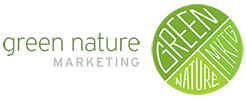When a movement is in its infancy many areas seek out their identity. Currently, within the green movement a tremendous amount of terminology is being used with varying interpretations. At times you may even wonder if you are speaking the same language.
Below is Green Nature Marketing’s attempt to establish a baseline of terms associated with the green movement. As time goes on and the green movement expands, we expect additional terms to be added. Below are a few for your review:
Biocompatible
As distinct from biodegradable, refers to products that break down not simply into basic elements, but into elements that are actually beneficial or not harmful to the environment.
Biological Nutrient
A biodegradable material posing no immediate or eventual hazard to living systems that can be used for human purposes and can safely return to the environment to feed environmental processes.
Biodegradable Material
An organic compound that can be degraded or converted to more simple compounds by microorganisms in the natural environment.
Carbon Footprint
The total amount of carbon dioxide (CO2) and other greenhouse gases emitted over the full life cycle of a product or service.
Commingle
To blend together similar recyclable materials such as mixed brown, green, and clear glass – but separate from disposable materials in the waste stream.
Compost
A mixture that consists largely of decayed organic matter and is used for fertilizing and conditioning land.
Cradle To Cradle
In cradle to cradle production all material inputs and outputs are seen either as technical or biological nutrients. Technical nutrients can be recycled or reused with no loss of quality and biological nutrients composted or consumed.
Cradle To Grave
Cradle to grave refers to a company taking responsibility for the disposal of goods it has produced, but not necessarily putting products’ constiuent components back into service.
Decomposition
The breakdown of organic wastes by various means. Complete chemical oxidation leaves only carbon dioxide, water, and inorganic solids.
Dioxin
A highly toxic by-product of industrial chemical processes, forms when chlorine is exposed to extreme heat. Commonly found where industrial waste enters the water, dioxin is most prevalent in waste from pulp and paper mills.
Enzymes
A class of proteins produced by living organisms to speed up chemical reactions used to convert food into simple compounds for easy digestion and removal.
Generators
Any residential or commercial facility that produces material to be disposed of through a waste stream system.
Greenwashing
The practice of companies making their products appear to be environmentally sound by putting them in green packages, claiming they are biodegradable (when they are not), etc.
Post-Consumer
Material that has completed its life as a consumer item and has been discarded for disposal or recovery. It often refers to paper products such as newspaper, white paper and magazines, that have been recycled to make new products.
Pre-Consumer
Material that has been discarded by commercial enterprise for disposal or recovery. Pre-consumer waste often refers to material such as paper products that have been recovered from industry and recycled into new products.
Product Life Cycle Analysis
To examine how much a product impacts the environment, it is necessary to account for all the inputs and outputs throughout the life cycle of that product, from its birth, including design, raw material extraction, material production, part production, and assembly, through its use, and final disposal.
Recycle
The separation, processing, conversion and marketing of waste material like glass and aluminium from the waste stream so it can be converted into new and useful product.
Renewable Resource
A natural resource that can be replenished by natural means at rates comparable to its rate of consumption.
Reuse
To use a material more than once.
Source Reduction
The reduction of weight and volume of waste being generated and consumed by making changes to manufacturing and production practices at the source of generation.
Source Separation
The act of segregating recyclable materials from other waste products in the home or business for collection and transportation to a recycling facility.
Sustainability
A goal that aims toward preserving quality interactions with the local environment, economy and social system.
Tipping Fee
A fee charged at a waste management facility for disposing waste based on the amount disposed.
Waste Stream
Is the flow or movement of wastes from the point of generation (i.e. household or commercial premises) to final disposal (i.e. landfill). A waste stream may reduce significantly over time as valuable items are separated for recycling and are recovered through resource recovery.
Food Terms:
Gluten Free
A gluten-free diet is a diet that excludes foods containing the protein gluten. Gluten is a protein found in grains such as wheat, rye and malts
Non-GMO
The Non GMO Project Verified label assures the consumer that food items have not been contaminated with genetically modified organisms.
USDA Organic
Organic agriculture produces products using methods that preserve the environment and avoid most synthetic materials such as pesticides and antibiotics.
Dairy Free
Food free of Lactose, a type of sugar found in milk and other dairy foods.
Peanut / Tree Nut Free
Food free of peanuts or peanut oil.
Vegetarian
The practice of subsisting on a diet composed primarily or wholly of vegetables, grains, fruits, nuts, and seeds, with or without eggs and dairy products.
Vegan
A strict vegetarian who consumes no animal food or dairy products.
Fair Trade
A movement to create greater equity in international trading partnerships through dialogue, transparency and respect. It promotes sustainable development by offering better trading conditions to, and securing the rights of, marginalized producers and workers in developing countries.







